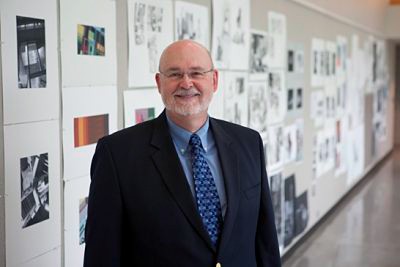GVSU keeping ahead in foreign language

Courtesy Photo / gvsu.edu Frederick J. Antczak, College of Liberal Arts and Sciences Dean
Jan 24, 2011
The United States is falling behind in foreign languages, but while the rest of the country is seeing a steady decrease in people speaking multiple languages, Grand Valley State University has seen an overall increase in the number of students studying languages.
Anne Caillaud, chair of the GVSU Department of Modern Languages and Literatures, said that there has been a 14-percent increase since 2007.
Last month, the CIA hosted a national Foreign Language Summit to discuss the need for educators to teach the language skills that are vital to success in a multilingual world. Foreign language educators at Grand Valley State University not only agree with this sentiment, but have worked hard to prepare students for that multilingual world.
“In our global world where everything is interconnected linguistically and culturally, it is very important that Americans be able to communicate effectively with others,” said Anne Caillaud, chair of the GVSU Department of Modern Languages and Literatures. “Multilingualism is the norm around the world. Within the United States, several states, such as New Mexico, define their state language as English-Plus. Other states have policies that promote multilingualism.”
Students seeking their Bachelor of Arts degree at GVSU are required to fulfill a three-semester proficiency in foreign language, which provides a basic knowledge of language.
Frederick Antczak, dean of the College of Liberal Arts and Sciences, said that he recommends students take more than the required three semesters.
“Three semesters provides the minimum to operate in a language, but it’s really more like a foundation on which you can build further learning,” said Antczak. “And you benefit directly from the decision to go on.”
Students seeking the Bachelor of Science are not required to study foreign languages, and instead must meet mathematical and scientific requirements that could perhaps be seen as a substitution, Antczak said. A bachelor’s degree is 120 hours and for the B.S. degree, many of them are taken up with courses for the major and other cognates.
“But I’m not aware of any field in which the students would not benefit from language study,” said Antczak. “If a student leaves here with a B.S. and no language, it’s a massive opportunity missed. It’s hard to conceive of a 21st century job in which knowledge of a foreign language wouldn’t make you more hirable and more effective. There’s an arithmetic limit to what you can require in a 120 hour bachelor’s program. But even in electives, study in foreign languages is both smart and wise for more people who will live and work in this century.”
GVSU teaches 10 modern languages: Arabic, Chinese, French, German, Italian, Japanese, Korean, Polish, Russian, and Spanish. Antczak added that the university’s classic languages are also prospering.
To help students develop language skills in the these languages, the GVSU Language Resource Center (LRC) provides interactive technology and hours of media to promote language learning, said David Shultz, director of the Language Resource Center.
“From the most rudimentary level, we provide the resources that accompany the textbooks,” said Shultz. “And that’s a very important thing. Without those supplemental resources, it would be much more difficult for students to really delve into their language studies.”
The LRC provides students with what Shultz described as passive learning, which involves the absorption of language skills by watching authentic foreign films, by listening to music. Most importantly, Shultz said that students learn by attempting to replicate those language skills in a creative venue, such as by creating a foreign language podcast in GarageBand, one of the many programs that the LRC provides to students in the Modern Languages and Literature Department.
Shultz, like Caillaud, emphasized the importance of learning foreign languages.
“Our students will be interacting with an increasingly diverse population,” said Caillaud. “West Michigan has a rich linguistic and cultural background. Last year, a poll for the Grand Rapids Public Schools identified over 80 different languages spoken as the main language in Grand Rapids households. Our community is rich with diversity. At GVSU, we reflect that reality and provide the opportunity to develop knowledge, understanding and respect for other language and cultures.”
>>
A look at the LRC
Hours logged by students since Fall 2008: 10,376
Number of students visiting the LRC per year: 5,000
Number of computer workstations in the LRC: 67
Number of foreign language films in the LRC collection: 2,200
Number of foreign language music albums in collection: 353






















